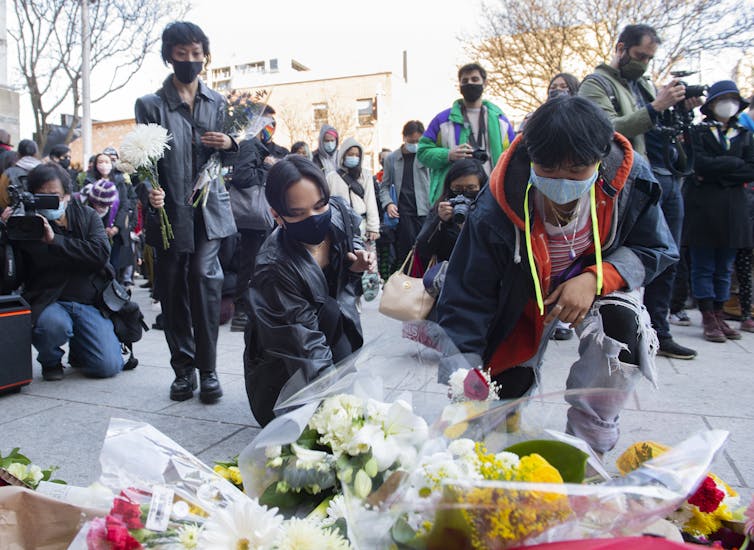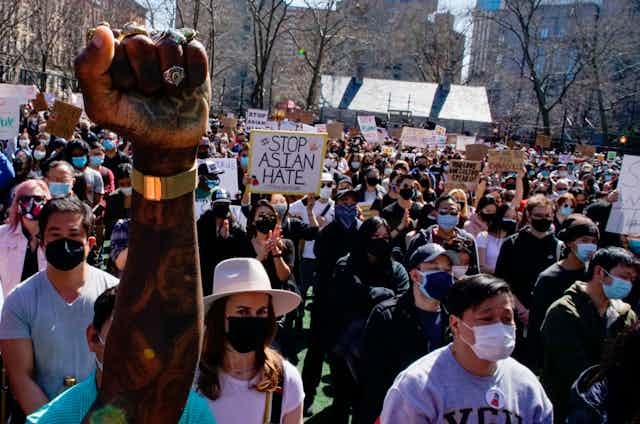Anti-Asian racism has been present in Canada for centuries. It is deeply rooted in the historical formation of Canada through the Chinese head tax, Japanese internment camps, the Electoral Franchise Act, which explicitly denied Chinese Canadians the right to vote, and more. It is embedded within the minds of Canadians.
In a recent interview, Prime Minister Justin Trudeau attributed the rise of anti-Asian racism during COVID-19 partly to “a more assertive and aggressive China on the world stage, combined with a global pandemic that had its origins in China.” By citing the pandemic and China’s foreign policy as causes of anti-Asian attacks, Trudeau is reinforcing this racist bias rather than fighting against it.
Contemporary anti-Asian racism stems from a history of systemic racism and racial profiling. It can be traced back to the “yellow peril” discourse that depicts Asians as a threat.
Read more: Coronavirus: The 'yellow peril' revisited
The pandemic serves as an opportunity for established, underlying currents of anti-Asian, and other forms of racism, to surface.
Anti-Asian racism affects us as Asian Canadians in our daily lives and in our careers. It is for this reason that we, a group of Asian Canadian scholars, have recently come together to discuss the structural roots of anti-Asian racism and the road ahead.
Settler colonialism
Canada is a settler colonial state. This means the country was built on and still operates under colonial rule — settler colonialism is a process of foreign intrusion and domination where large numbers of settlers claimed the land and power over it and its residents.
Read more: Not in the past: Colonialism is rooted in the present
This process involves the decimation of Indigenous populations by the state to make Canada “white.” It also involves immigrant exploitation and racial exclusion to keep Canada “white.”
Despite Asians (for example, early Chinese immigrants) arriving in Canada before it became a nation, Asian people have never been fully accepted as Canadians.
Instead, from as early as the era of transcontinental railroad building, which relied on the cheap labour of Chinese workers, Asians have been a vulnerable labour force whose existence was purposefully controlled at the border.

A look at history
Limiting Asian immigration began in 1885 with the imposition of a head tax on Chinese migrants. The Komagata Maru incident, that excluded immigrants from India, illustrates the agenda to build Canada as “a white man’s country.”
Between 1895 and 1950, there were more than 175 anti-Asian laws in Canada. They were created to assure white domination.
Today, Canada’s immigration policies continue to exploit Asian Canadians and immigrants all under the interests of white (re)settlement by forcing migrants to settle in particular parts of the country. Years ago, special immigration incentives were enacted to attract selected, privileged groups such as wealthy migrants and those with foreign capital investment.
The racialized temporary migrant labour programs such as migrant live-in caregiver program (predominantly Filipina women), admit migrant workers into the country to perform labour deemed unattractive, yet necessary, for the well-being of Canadians. These migrant workers often remain within a few, lower-skilled occupations when they switch jobs, even after receiving legal permanent resident status.
Read more: Coronavirus: Canada stigmatizes, jeopardizes essential migrant workers
The limits of multiculturalism
The policy and practice of multiculturalism has largely failed to address widespread racial and ethnic disparities in Canada. Thus far, it has only served to maintain the status quo, preserving the cultural hegemony of the dominant group.
After half a century of this policy being in place, racialized people are still invisible in many of Canada’s institutions. As education scholar Carl E. James has noted English Canadians, and to a lesser extent, French Canadians have continued to play a central role in defining Canadian society and culture.
Canada’s “management” of ethno-cultural diversity through multiculturalism has also failed to control racism against these communities. Instead, despite its pretence, Canadian multiculturalism provides a tacit basis for discrimination and racial violence.

Promoting multiculturalism as Canada’s national identity has allowed Canadians to ignore the harsh lived reality of many minorities, and to refute the claim that racism is alive and well in Canada. Denying its existence allows racism to fester and persist.
This contributes not only to the rise of anti-Asian racism during COVID-19, but also to the fact that racism against Asians isn’t part of the discussion. Canada’s recent Anti-Racism Strategy failed to mention long standing racial violence against Asians at all.
In accepting but not embracing cultural difference, multiculturalism serves as an institutional mechanism that protects whites from social interaction with visible minorities. It has contributed to the creation of segregated racial and ethno-cultural enclaves. Anti-Asian racism is integrally tied to the fact that Asian Canadians continue to be segregated socially, economically and politically in Canada.
By portraying Asians as hard-working, independent, intelligent and economically prosperous, the model minority stereotype was created to support the view that systemic racism against Asians does not exist since they have “succeeded” in Canada.
Read more: The model minority myth hides the racist and sexist violence experienced by Asian women
This myth denies the socio-economic, political and educational challenges faced by many working-class Asian Canadians. It also ignores the tremendous heterogeneity and diversity within the broader Asian Canadian population – which in reality, is made up of a multitude of ethnicities, cultures, languages, class and immigration experiences.
Road ahead
Anti-Asian racism is more widespread than we think. Solutions cannot be limited to educating people about Asian history in Canada and globally, or to the harms of anti-Asian racism. We need greater visibility of Asians and members of all racialized groups across sectors, as decision-makers and we must recognize their contributions throughout history and to contemporary society.
To fight anti-Asian racism means to fight against any form of racism. We must come together to do so and not forget what got us here.

